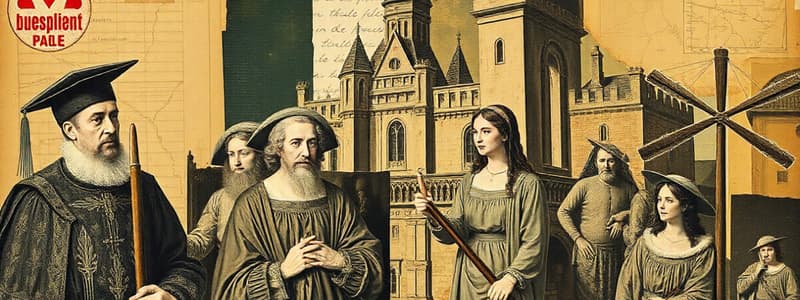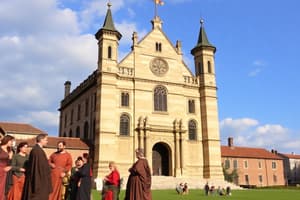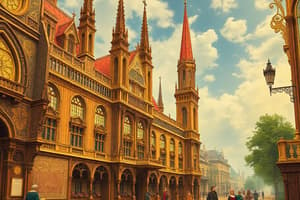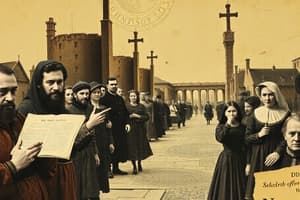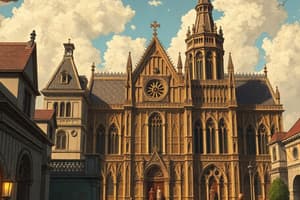Podcast
Questions and Answers
What does the term 'Renaissance' mean?
What does the term 'Renaissance' mean?
- Rebirth (correct)
- Reformation
- Revolution
- Rediscovery
Which movement was started to reform practices in the Catholic Church?
Which movement was started to reform practices in the Catholic Church?
- The Rediscovery
- The Reformation (correct)
- The Revolution
- The Renaissance
Who is credited with beginning the Reformation?
Who is credited with beginning the Reformation?
- Erasmus
- Chancellor Rolin
- Jan van Eyck
- Martin Luther (correct)
Which invention significantly aided the spread of Renaissance and Reformation ideas?
Which invention significantly aided the spread of Renaissance and Reformation ideas?
What city is identified as the starting point of the Reformation?
What city is identified as the starting point of the Reformation?
What type of art did Renaissance artists admire?
What type of art did Renaissance artists admire?
Which artistic technique makes distant objects appear smaller than close ones?
Which artistic technique makes distant objects appear smaller than close ones?
In what way did trade with the East influence the Renaissance?
In what way did trade with the East influence the Renaissance?
Christine de Pizan is known for what?
Christine de Pizan is known for what?
What did Christine de Pizan argue for in The Book of The City of Ladies?
What did Christine de Pizan argue for in The Book of The City of Ladies?
Which of Shakespeare's plays is an example of a tragedy?
Which of Shakespeare's plays is an example of a tragedy?
During what period did the Renaissance spread to England?
During what period did the Renaissance spread to England?
The Elizabethan Age is named after which monarch?
The Elizabethan Age is named after which monarch?
Shakespeare's works are often adapted into what form of media today?
Shakespeare's works are often adapted into what form of media today?
Which languages did Queen Elizabeth I speak?
Which languages did Queen Elizabeth I speak?
In block printing, what material is used to carve words or letters?
In block printing, what material is used to carve words or letters?
Who is considered the most famous writer of the Elizabethan Age?
Who is considered the most famous writer of the Elizabethan Age?
Where was William Shakespeare born?
Where was William Shakespeare born?
Which of the following is true about Bi Sheng's invention?
Which of the following is true about Bi Sheng's invention?
What was one of the key aspects of Shakespeare's plays?
What was one of the key aspects of Shakespeare's plays?
Why was movable type impractical for Chinese printers?
Why was movable type impractical for Chinese printers?
From which country did block-printed items reach Europe?
From which country did block-printed items reach Europe?
What did European printers create using block printing?
What did European printers create using block printing?
What was a common way to travel quickly across London?
What was a common way to travel quickly across London?
Which area of London housed most of the theaters?
Which area of London housed most of the theaters?
Approximately how many people traveled across the Thames to Southwark on days when playhouses were open?
Approximately how many people traveled across the Thames to Southwark on days when playhouses were open?
Who initiated the Reformation due to protests against the Catholic Church?
Who initiated the Reformation due to protests against the Catholic Church?
What is the term for the pardon sold by the Catholic Church that Martin Luther protested against?
What is the term for the pardon sold by the Catholic Church that Martin Luther protested against?
What is the name given to the religious groups that formed as a result of the Reformation?
What is the name given to the religious groups that formed as a result of the Reformation?
Which agreement brought temporary peace between the Holy Roman Empire and the Lutherans?
Which agreement brought temporary peace between the Holy Roman Empire and the Lutherans?
What is the term for declaring a marriage invalid?
What is the term for declaring a marriage invalid?
Leonardo da Vinci is best described as what?
Leonardo da Vinci is best described as what?
What made Leonardo da Vinci a true 'Renaissance man'?
What made Leonardo da Vinci a true 'Renaissance man'?
What is one of Leonardo da Vinci's most famous paintings?
What is one of Leonardo da Vinci's most famous paintings?
What is unique about Leonardo da Vinci's surviving notebooks?
What is unique about Leonardo da Vinci's surviving notebooks?
Besides painting, what other area did Michelangelo excel in?
Besides painting, what other area did Michelangelo excel in?
What was Raphael Sanzio most known for painting?
What was Raphael Sanzio most known for painting?
What artistic technique was Raphael famous for using?
What artistic technique was Raphael famous for using?
Who did Raphael learn from by studying their works?
Who did Raphael learn from by studying their works?
What did the Peace of Augsburg determine?
What did the Peace of Augsburg determine?
Who initially gave Henry VIII the title 'Defender of the Faith'?
Who initially gave Henry VIII the title 'Defender of the Faith'?
What was Henry VIII's primary motivation for breaking with the Roman Catholic Church?
What was Henry VIII's primary motivation for breaking with the Roman Catholic Church?
What was Charles V's initial goal regarding religion in his lands?
What was Charles V's initial goal regarding religion in his lands?
In what year did Charles V defeat the Protestant princes?
In what year did Charles V defeat the Protestant princes?
What was the main issue that led to conflict between Charles V and the Protestant princes?
What was the main issue that led to conflict between Charles V and the Protestant princes?
Prior to his break with the Catholic Church, what was Henry VIII's stance on Martin Luther's ideas?
Prior to his break with the Catholic Church, what was Henry VIII's stance on Martin Luther's ideas?
What city was the Peace of Augsburg established in?
What city was the Peace of Augsburg established in?
Flashcards
Leonardo da Vinci
Leonardo da Vinci
Painter, sculptor, inventor, and scientist of the Renaissance.
Mona Lisa
Mona Lisa
A famous portrait painted by Leonardo da Vinci.
The Last Supper
The Last Supper
A religious painting by Leonardo depicting Jesus' final meal with his disciples.
Raphael
Raphael
Signup and view all the flashcards
Raphael's Madonna & Child Expressions
Raphael's Madonna & Child Expressions
Signup and view all the flashcards
Perspective
Perspective
Signup and view all the flashcards
Michelangelo
Michelangelo
Signup and view all the flashcards
Michelangelo Buonarroti
Michelangelo Buonarroti
Signup and view all the flashcards
Renaissance
Renaissance
Signup and view all the flashcards
Causes of the Renaissance
Causes of the Renaissance
Signup and view all the flashcards
Reformation
Reformation
Signup and view all the flashcards
Martin Luther
Martin Luther
Signup and view all the flashcards
Printing Press
Printing Press
Signup and view all the flashcards
Impact of Printing Press
Impact of Printing Press
Signup and view all the flashcards
Perspective in Art
Perspective in Art
Signup and view all the flashcards
Classical Influence
Classical Influence
Signup and view all the flashcards
Christine de Pizan
Christine de Pizan
Signup and view all the flashcards
Pizan's Argument
Pizan's Argument
Signup and view all the flashcards
Elizabethan Age
Elizabethan Age
Signup and view all the flashcards
Elizabeth I
Elizabeth I
Signup and view all the flashcards
William Shakespeare
William Shakespeare
Signup and view all the flashcards
Globe Theater
Globe Theater
Signup and view all the flashcards
Shakespeare's Inspiration
Shakespeare's Inspiration
Signup and view all the flashcards
Shakespeare's Themes
Shakespeare's Themes
Signup and view all the flashcards
Renaissance Human Nature
Renaissance Human Nature
Signup and view all the flashcards
Shakespeare's Famous Plays
Shakespeare's Famous Plays
Signup and view all the flashcards
Shakespeare's Film Influence
Shakespeare's Film Influence
Signup and view all the flashcards
Block Printing
Block Printing
Signup and view all the flashcards
Movable Type
Movable Type
Signup and view all the flashcards
Movable Type in China
Movable Type in China
Signup and view all the flashcards
Block Printing in Europe
Block Printing in Europe
Signup and view all the flashcards
European Block Printing Use
European Block Printing Use
Signup and view all the flashcards
Thames River Crossing
Thames River Crossing
Signup and view all the flashcards
The Reformation
The Reformation
Signup and view all the flashcards
The Catholic Church
The Catholic Church
Signup and view all the flashcards
Indulgence
Indulgence
Signup and view all the flashcards
Lutheran
Lutheran
Signup and view all the flashcards
Annul
Annul
Signup and view all the flashcards
Peace of Augsburg
Peace of Augsburg
Signup and view all the flashcards
Catholic Interpretation
Catholic Interpretation
Signup and view all the flashcards
Protestant Interpretation
Protestant Interpretation
Signup and view all the flashcards
Charles V
Charles V
Signup and view all the flashcards
Henry VIII's Early Title
Henry VIII's Early Title
Signup and view all the flashcards
Henry VIII's motivation to break with Catholic Church
Henry VIII's motivation to break with Catholic Church
Signup and view all the flashcards
Henry VIII's Divorce
Henry VIII's Divorce
Signup and view all the flashcards
Reasons for England's split from the Catholic Church
Reasons for England's split from the Catholic Church
Signup and view all the flashcards
Study Notes
European Renaissance and Reformation, 1300-1600
-
Trade with the East and the rediscovery of ancient manuscripts led Europeans to develop new ideas about culture and art.
-
This period was called the Renaissance, meaning rebirth.
-
Martin Luther began a movement to reform practices in the Catholic Church he believed were wrong.
-
That movement, the Reformation, led to the founding of non-Catholic churches.
-
The printing press allowed books and pamphlets to be made faster and more cheaply.
-
This technology helped spread the revolutionary ideas of the Renaissance and Reformation.
Renaissance Begins in Italian City-States
- In the 1300s, the Renaissance began in Italian city-states like Florence, Milan, and Mantua.
Mali King's Pilgrimage
- In 1324, Mali king Mansa Musa made a pilgrimage to Mecca.
Hongwu Founds Ming Dynasty
- In 1368, Hongwu founded the Ming Dynasty in China, starting the era in China.
Chinese Exploration
- In 1405, Chinese explorer Zheng He began exploration of Asia and Africa.
Medici Family Takes Control of Florence
- The Medici family took control of Florence in 1434.
Gutenberg Bible Printed
- In 1455, Gutenberg's Bible was printed in Mainz.
Ottoman Turks Capture Constantinople
- In 1453, the Ottoman Turks captured Constantinople.
Columbus Reaches the Americas
- In 1492, Columbus reached the Americas.
Martin Luther Begins Reformation
- In 1517, Martin Luther began the Reformation in Wittenberg.
English King Starts Church of England
- In 1534, English King Henry VIII started the Church of England.
Mughal Empire Established
- In 1526, Babur established the Mughal Empire in India.
Council of Trent Mandates Reforms
- In 1563, the Council of Trent mandated reforms in the Catholic Church.
Italy: Birthplace of the Renaissance
- The Italian Renaissance was a rebirth of learning that produced great art and literature.
- Renaissance art and literature still influence modern thought and art.
- Europe suffered from war and plague in the late Middle Ages, leading survivors to celebrate life and the human spirit.
- People began to question medieval institutions, including the Church, which couldn't prevent war or relieve suffering from the plague.
- Writers and artists began to experiment with different styles in northern Italy, changing how Europeans saw themselves.
- This movement caused an explosion of creativity in art, writing, and thought from 1300 to 1600.
- Renaissance means rebirth and refers to a revival of art and learning.
- Educated Italians hoped to revive classical Greek and Roman culture, yet created something new, leading to innovative styles of art and literature.
- New values, such as the importance of the individual, emerged.
- The Renaissance eventually spread from northern Italy to the rest of Europe.
- Three advantages made Italy the birthplace of the Renaissance: thriving cities, a wealthy merchant class, and classical Greek/Roman heritage.
- Overseas trade spurred growth of city-states in Northern Italy, making the region urban while the rest of Europe was mostly rural.
- Cities were ideal for intellectual revolution as places to exchange ideas.
- The bubonic plague in the 1300s killed up to 60 percent of the population, bringing economic changes and higher wages for survivors.
- Merchants began pursuing art due to fewer opportunities to expand business.
Merchants and the Medici
- A wealthy merchant class developed in each Italian City-State. City-states like Milan and Florence were relatively small, allowing a high percentage of citizens to be involved in political life.
- Merchants dominated politics, using their wits to succeed in business rather than inheriting social rank.
- Belief in individual achievement became important during the Renaissance.
- Florence had a republican government since the late 1200s, but came under the rule of the Medici banking family during the Renaissance.
- The Medici family had bank branches throughout Italy and major European cities.
- Cosimo de Medici, the wealthiest European of his time, took control of Florence's government in 1434 by influencing council members with loans.
- He was a dictator in Florence for 30 years although he never sought political office,
- After Cosimo de Medici died in 1464, his family continued to control Florence.
- Lorenzo de Medici, known as Lorenzo the Magnificent, came to power in 1469.
- He ruled as a dictator but had the appearance of having an elected government.
Looking to Greece and Rome
- Renaissance scholars looked down on Middle Ages art and literature, desiring to return to Greek and Roman learning.
- Italian artists and scholars drew inspiration from the Roman ruins around them.
- Western scholars studied ancient Latin manuscripts preserved in monasteries.
- Christian scholars fled to Rome with Greek manuscripts from Constantinople when the Turks conquered it in 1453.
Classical and Worldly Values
- Scholars became influenced by classical ideas which helped them develop new outlook on life.
- The study of classical texts led to humanism, an intellectual movement that focused on human potential and achievements.
- Humanists studied classical texts to understand ancient Greek values.
- They influenced artists and architects to carry on classical traditions. Humanists also popularized the study of subjects such as history, literature, and philosophy, known as the humanities.
- Humanists suggested people could enjoy life without offending God, unlike the Middle Ages, where piety was demonstrated by wearing rough clothing and eating plain foods.
- People enjoyed material luxuries, good music, and fine food as long as they remained devout Catholics during Renaissance Italy.
- Renaissance society was mainly secular rather than spiritual and concerned with the here and now.
- Even church leaders became more worldly, living in beautiful mansions, throwing lavish banquets, and wearing expensive clothes.
Patrons of the Arts
- Church leaders during the Renaissance beautified Rome and other cities by spending money on art, therefore becoming patrons.
- Renaissance merchants and wealthy families were patrons of art to create more personalized works of art.
- By having their portraits painted or donating art to the city, the wealthy demonstrated their importance.
The Renaissance Man
- Renaissance writers suggested that all educated people were expected to create art while striving to master almost every area of study.
- Those excelling in many fields were called universal men and later Renaissance men.
- Baldassare Castiglione wrote The Courtier (1528), a book that taught how to become a Renaissance man.
- Qualities include being charming, witty, well educated in the classics, as well as being skilled in dance, singing, music, poetry, riding, wrestling, and swordsmanship.
The Renaissance Woman
-
Upper-class women should know the classics and be charming but were not expected to seek fame, according to The Courtier.
-
They were expected to inspire art but rarely to create it, although their skills could not be hidden. Upper-class Renaissance became better educated than medieval women, however, most had little political influence.
-
A few women, such as Isabella d’Este, exercised power.
-
Born into the ruling family of Ferrara, she married the ruler of Mantua.
-
Isabella brought many Renaissance artists to her court and built a famous art collection.
-
She was also skilled in politics, so she defended Mantua and won his release while her husband was captive in war.
-
Renaissance patrons like Isabella d'Este supported dozens of artists working in northern Italy, advancing artistic styles,
-
Medieval artists used religious subjects to convey a spiritual ideal, however, Renaissance artists portrayed religious subjects using a realistic style copied from classical models.
-
Greek and Roman subjects also became popular, where painters used the technique of perspective to show three dimensions on a flat surface.
-
Following the new emphasis on humanism individuals, painters began to paint portraits of prominent citizens which revealed what was distinctive about each person.
-
Michelangelo Buonarroti, a sculptor, poet, architect, and painter, used a realistic style when depicting the human body.
-
Donatello made sculpture more realistic by carving natural postures and expressions that reveal personality.
Leonardo, Renaissance Man
- Leonardo da Vinci, a true "Renaissance Man", was a famous painter, sculptor, inventor, and scientist who was curious about how things worked.
- His well-known masterpieces include the Mona Lisa, The Last Supper where he showed the personalities of Jesus' disciples through facial expressions.
- Raphael Sanzio was younger than Michelangelo and Leonardo, and he learned from studying their works.
- One his well known pieces was of the Madonna and child, where he portrayed their emotions and gentle and calm.
- In his greatest achievement, Raphael painted famous Renaissance figures such as Michelangelo, Leonardo, and himself as classical philosophers and their students in the School of Athens.
- Renaissance society generally restricted women's roles, although some Italian women became painters like Sofonisba Anguissola, Artemisia Gentileschi.
Renaissance Writers Change Literature
- Renaissance writers produced works that reflected their time, using new techniques that some writers rely on today.
- Dante wrote in the vernacular, his native language, instead of Latin, like many Renaissance writers that wrote based on self-expression.
- Renaissance created trends that modern day writers follow.
- Petrarch, one of the earliest and most influential humanists, was also a great poet who called the father of Renaissance humanism.
- Giovanni Boccaccio is best known for the Decameron, a series of realistic, sometimes off-color stories told by young people waiting in a rural villa to avoid the plague.
- Machiavelli's The Prince (1513) examines the imperfect conduct of human beings by examining the ways a ruler can gain and maintain power.
- Renaissance women writers like Vittoria Colonna wrote about personal subjects due to social expectations.
The Northern Renaissance
- In the 1400s, ideas of the Italian Renaissance spread to Northern Europe and are now a big part of modern thought.
- By 1450, northern Europe's population grew following the bubonic plague, after France and England ended the Hundred Years' War, many cities grew fast.
- Urban merchants were wealthy enough to sponsor artists, beginning in Flanders, which was rich from long-distance trade and the cloth industry.
- England and France unified under strong monarchs, who sponsored the arts and hired artists to rebuild castles.
- Renaissance ideas mingled with northern traditions, leading to the character of the northern Renaissance.
- Artists were especially interested in realism.
Artistic Ideas Spread
- In 1494, a French king launched an invasion through northern Italy to Naples, causing many Italian artists and writers to seek a safer life in Northern Europe.
- They brought along the techniques of the Italian Renaissance which would make its way to Europe.
- German artist Albrecht Dürer traveled to Italy to study in 1494, who produced woodcuts and engravings and other types of art.
- The support of wealthy merchant families in Flanders helped Flanders become Northern Europe's center, one painter was Jan van Eyck who used oil-based paints to paint, and he spread it to Italy.
- Flemish painting peaked after with the art produced by Pieter Bruegel, who also was skilled in painting realistic details and individual people.
Northern Writers Try to Reform Society
- Italian humanists were very interested in reviving classical languages and classical texts, however Italian humanist ideas reached the north, then began to focus on the teachings of the Church.
- Christian humanism formed was a reform to the people and what they did as humans.
- One of the most well known Christian humanist was Desiderius Erasmus of Holland followed close by Thomas More of England.
- Thomas More tried to show a better model of society.
The Elizabethan Age
- The Renaissance spread to Enland, a time known as th Elizabethan Age.
- The most famous writer in this period was William Shakespeare.
- Shakespeare, like many Renaissance writes revered the people from times before, making plots based off the beliefs from then.
Printing Spreads Renaissance Ideas
- The Chinese invented block printing and the Europeans improved on that by creating what is now a working printing press. Which helped the use of books to become easier.
- Printers first produce mainly of religious works to start but it made the works known to people.
Changes in the Arts
- Art techniques change to classical Greece and Rome.
- Paintings became more realistic in nature.
- Wrtiters start to use venicular laguages. The arts praised to be done as a individual.
- Paintings started to be displayed with new discoveries and charts which also helped spread new ways of art.
- Legal reasons now needed for books so their right. As well Chistians also tried reform soceity.
Vittoria Colonna
- Women during these time had rights to write, which in those times men thought they wern't too in touch with the subject but helped the community.
- At the end of the 15th century Renaissance began to spread north from italy due to Italian artist doing thing.
Luther Challenges the Church
- Martin parents wanted to have him be a lawyer, so they would attend many lawyer school after that Martin decided he would teach for the rest of his life and became more involved through the Church.
- Marin wanted to take a public stands against the new beliefs to what now would be called Luther's teachings.
- Martin wrote 95 Theses where is would show what he didn't agree with.
Studying That Suits You
Use AI to generate personalized quizzes and flashcards to suit your learning preferences.
